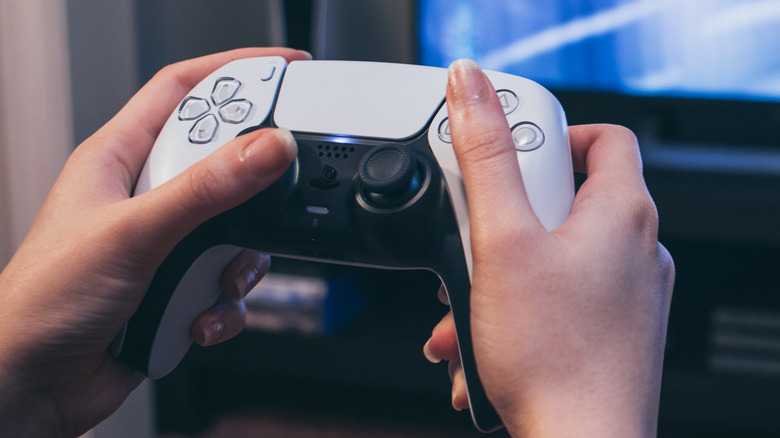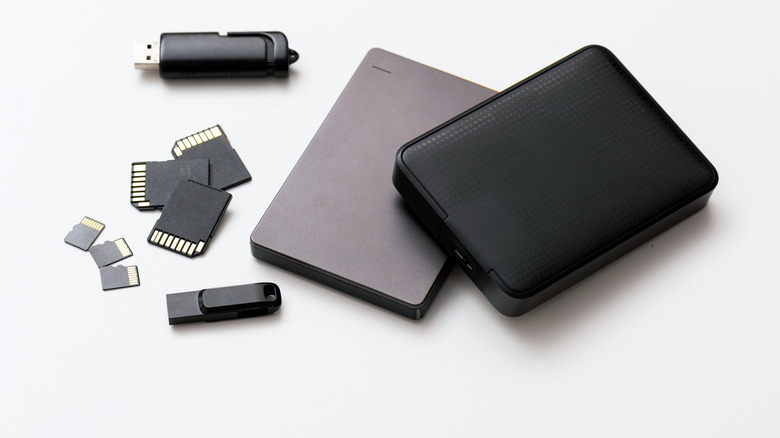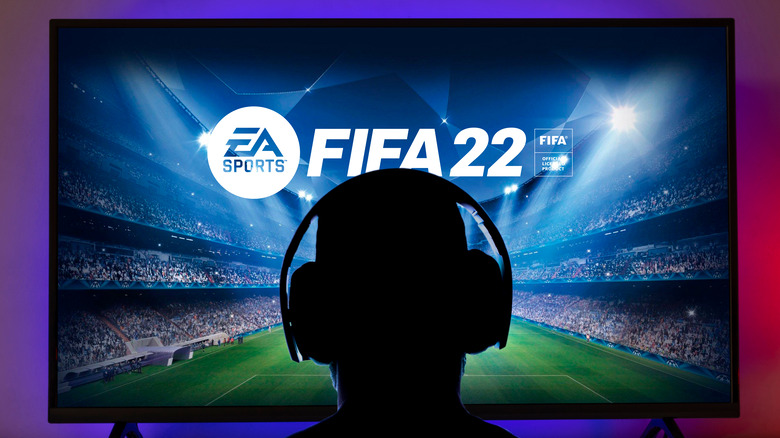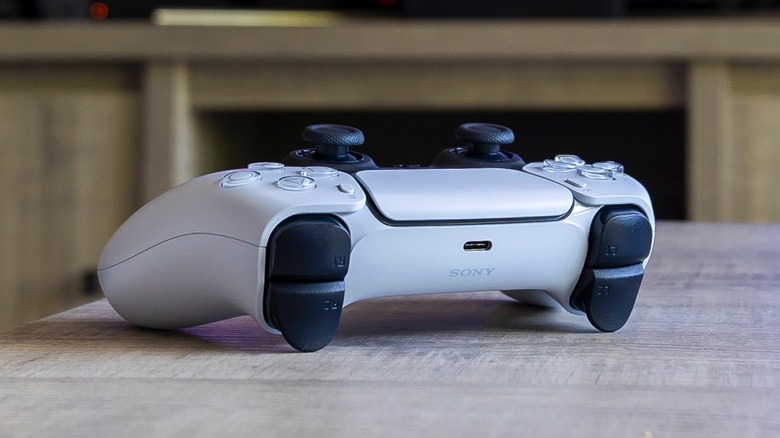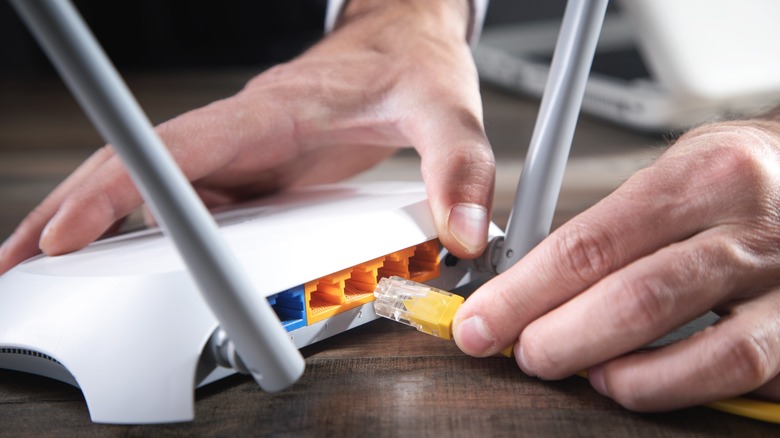Why Your PS5 Is Slow And What You Need To Do To Fix It
If you recently upgraded to a PlayStation 5, you're probably excited about all the groundbreaking new PS5 features and the prospect of gaming on a next-gen console. However, dealing with slow download speeds and lagging online gameplay is a quick way to ruin your brand new PS5 experience. From purchasing new games to retrieving saved data from cloud storage, next-gen consoles have become increasingly reliant on a stable internet connection, so if you want the full PS5 experience, it's essential to fix these issues as quickly as possible.
Fortunately, most slow download speeds and lagging problems are likely unrelated to the console itself. Whether you need to move your console closer to your Wi-Fi router or use an ethernet cable when downloading games or updates (via PlayStation), you can fix many of the most common issues that cause slow PS5 performance at home without the help of a professional. This means you can breathe a tentative sigh of relief that you don't need to send your PS5 back to Sony.
Free up space on your SSD
A full hard drive can be another contributor to slow PS5 performance. PS5 games take up much less space than PS4 games, according to GamePressure. As a result, you may be squeezing an extra game or two on your new SSD that you didn't have on your PS4. However, this practice can lead to clutter on your SSD, which can cause performance issues (via PureInfoTech).
To help free-up space, you should delete old games and apps you no longer use, according to PlayStation.
- On your PS5, navigate to Settings > Storage > Games and Apps.
- Click X on your controller and Choose Select Items to Delete.
- Check the boxes by the games and apps you want to remove and choose Delete.
In addition to deleting games and apps, you can also move old or rarely used files to external storage to ease the burden on your internal SSD.
- Plug your external storage device into your PS5 using either the USB-C port on the front or the USB-B port on the back.
- Navigate to Settings > Storage. Then, choose USB Extended Storage > Format as USB Extended Storage.
- Once you have formatted the external storage, navigate to your Game Library. Select the games or apps you would like to transfer, click the options button on your controller, and choose move Games and Apps (per PlayStation).
However, you should be aware that all external devices must be SuperSpeed USB 5 Gbps or later and a minimum of 250 GB, according to PlayStation.
Update your PS5 and games
Ensuring your PS5's software is updated is vital to maintaining performance with both your console's online and offline elements. Any time an update is available, your PS5 will prompt you to download and install the file when you boot up the device. However, you can also update your software manually if your console is frozen or unable to update automatically.
- On your computer, make a folder named "PS5". Then, drag that to a USB storage device that meets FAT32 format specifications, according to PlayStation.
- Inside the "PS5" folder, create a new folder named "UPDATE".
- Download the most recent PS5 console update file. Then, drag it to the "UPDATE" folder, ensuring you've saved it as "PS5UPDATE.PUP."
- Connect the USB storage device to your PS5. Then start your console in Safe Mode.
Once you've updated your console either manually or automatically, you should ensure that your games are up to date. Out-of-date firmware is the cause of many performance issues.
- On your PS5's Games Home, highlight the game you want to update, according to PlayStation.
- Then, click the Options button on your controller and choose Check for Update.
- Install the file by following the on-screen prompts when an update is available.
If you're the type that forgets to update your games manually, you can turn on automatic updates so you always remember (via PlayStation).
Clear the system software cache
If your PlayStation 5's performance isn't what it used to be, clearing the console's system software cache and rebuilding the database may help. To perform either of these tasks, the console will need to be launched in Safe Mode. To boot your PS5 up in Safe Mode, you'll need to:
- Shut down the console by holding the power button for three seconds.
- Hold down the power button again. You will hear one beep.
- Continue to hold the button for approximately seven seconds until you hear a second beep.
- Release the button after the second beep.
The console should now be in Safe Mode. While in this mode, the PS5's Bluetooth won't work, so connect a controller via a USB-C cable and press the PS button on the front of it. Scroll through the Safe Mode options and locate the one titled Clear Cache and Rebuild Database. Choose that option and then select Clear System Software Cache. This may solve your performance problems. The other option, "Rebuild Database" is a likely fix if you ever have system feature issues.
Clean the dust from your console
To put it simply, more performance tends to involve putting more electricity through components like the console's GPU and processor. This is how overclocking works on PCs. This also creates heat, hence why certain components come with large heatsinks and other cooling components. Conversely, if a component — or the console on the whole — is getting too hot, performance will be scaled down to prevent overheating. Even if your house is pretty clean, your console will spend most of its time sucking in dust as the fans designed to cool the system do their thing. A thick layer of dust is insulating; it will act like a blanket on your PlayStation's innards, reducing its ability to dissipate heat. Luckily, the fix is fairly simple: you need to remove the dust, which Sony made simple by design.
To remove the console's side panels, start by unscrewing and removing the console's base. Then, as in the video above, firmly grip the panels on two opposite corners before prising them away from the console and sliding the panel down. You'll notice two holes in the side of the console — these are used to clear the PlayStation 5's "dust catcher." Use a vacuum to suck dust and dirt from these holes, then reassemble your console. If the dust was successfully removed, your console may run smoother. While you may be tempted to give the inside a blast out with some compressed air, stripping the console any further will likely void the warranty and is risky, so you should probably just stick to the vacuum vents.
Troubleshoot your Wi-Fi's slow performance
While online gaming comes to mind when thinking about slow Wi-Fi for your PS5, multiplayer gaming is just one facet of your console's network capability. A stable network connection is required to do everything from chatting with friends to playing games if you have a digital PS5 (via Career Gamers). As a result, it's imperative to consider your home Wi-Fi network a vital piece of your next-gen gaming experience.
If you frequently experience problems such as slow download speeds and online gameplay, you should troubleshoot the issue by first examining your home Wi-Fi network. Given your network's constant strain, you may find a solution in resetting your whole system.
- Disconnect your router and modem from power for at least 30 seconds.
- Reconnect your router and modem to power.
- On your PS5, navigate to Settings > Network > Settings > Set Up Internet Connection and reconnect to your home Wi-Fi, according to PlayStation.
Resetting your home Wi-Fi is an excellent place to start, but if your PS5 is still experiencing slow network performance, consider using an ethernet cable. A wired connection might be particularly relevant for you if your existing PS5 set-up is several rooms or floors away from the router.
- Plug your PS5 into a router with an ethernet cable.
- On your PS5, navigate to Settings > Network > Settings > Set Up Internet Connection > Set Up Wired LAN, according to PlayStation.
- Choose Connect, and your console will automatically join your network.
If your router is too far from your gaming set-up, consider purchasing a mesh router system that will give you a stable LAN connection anywhere in your house.
